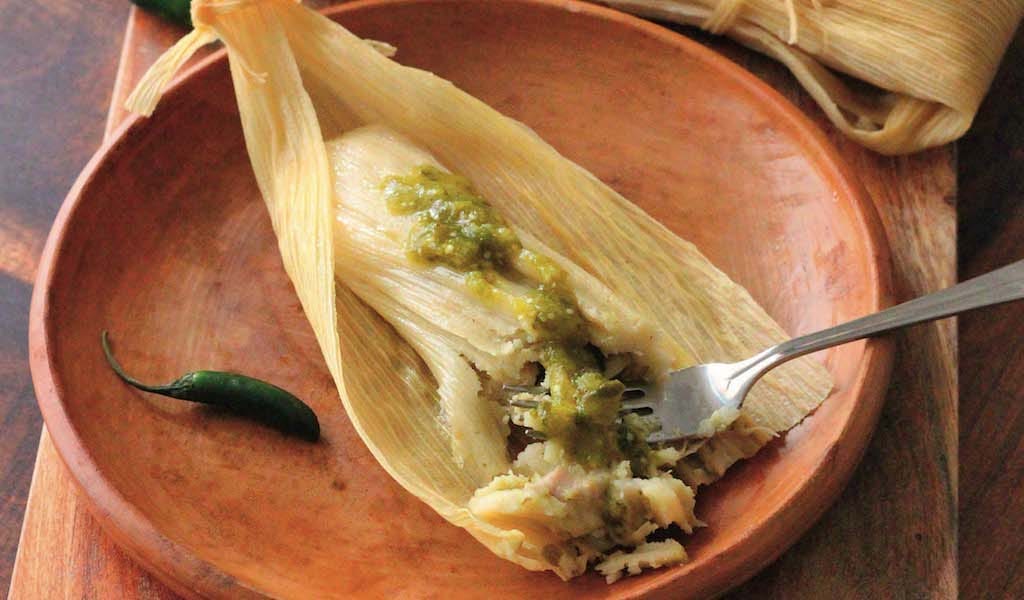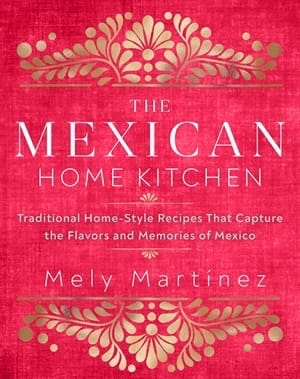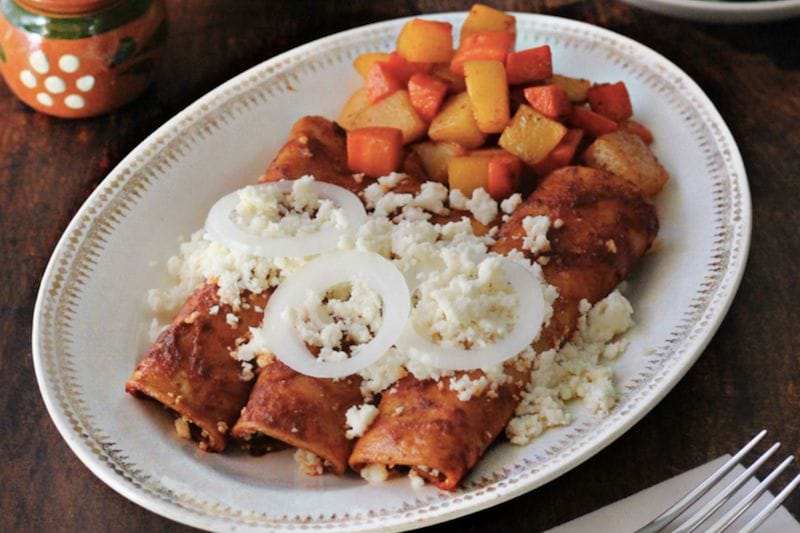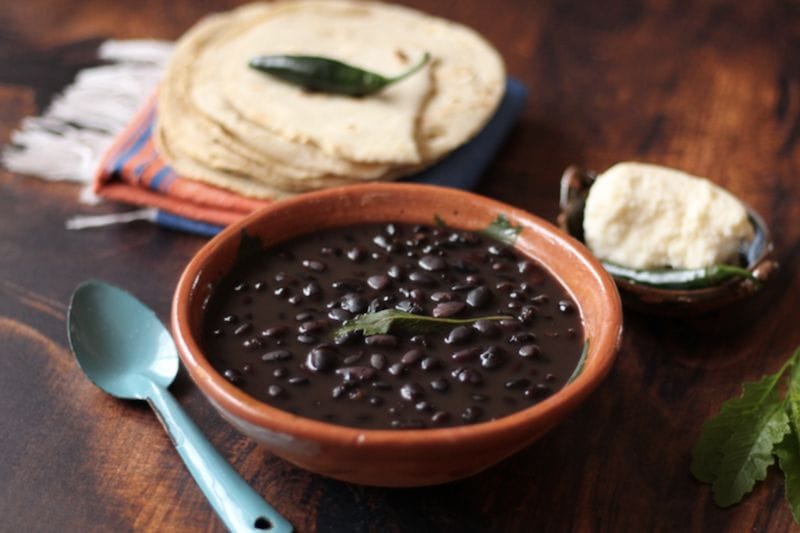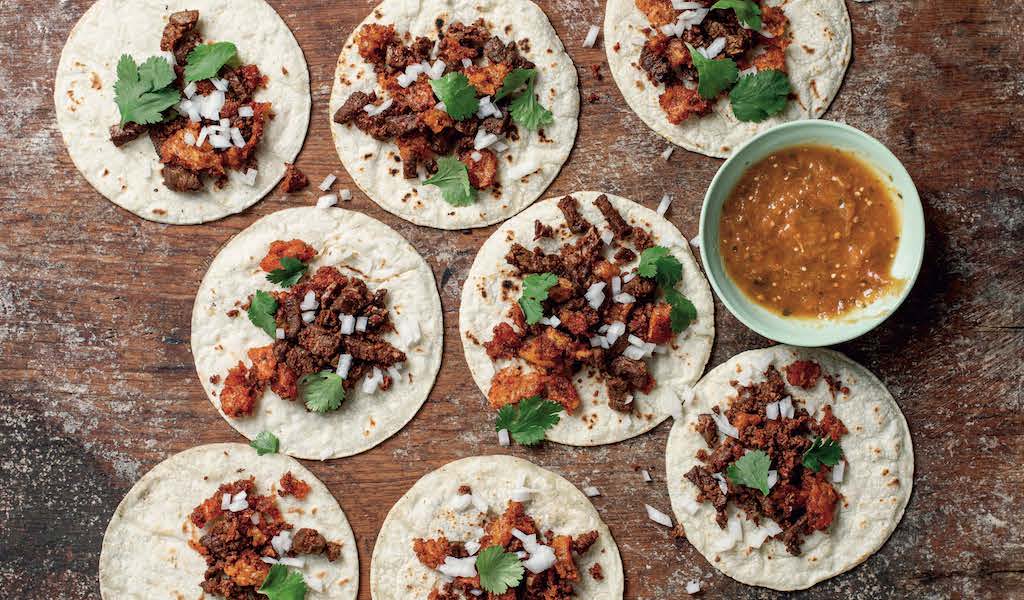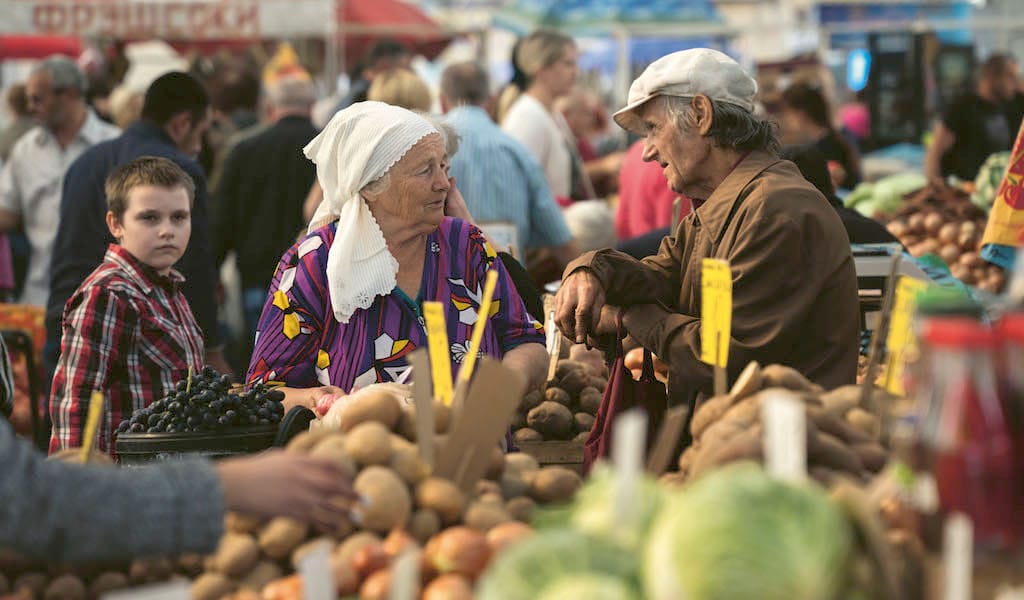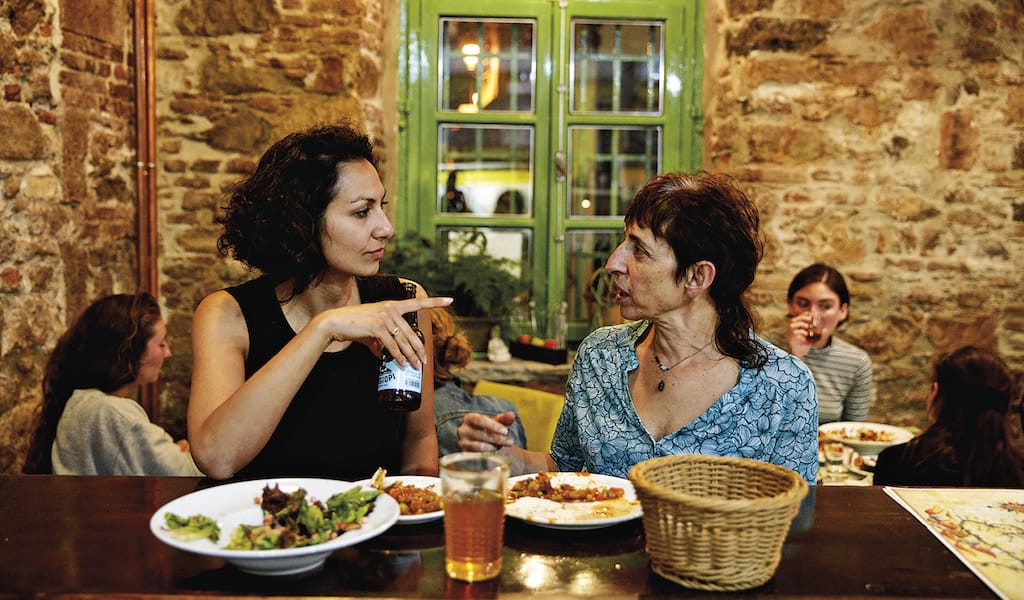We recently spoke to Mely Martínez about her cookbook, The Mexican Home Kitchen (Rock Point, September 2020), which compiles the traditional home-style dishes that feed Mexican families day in and day out. These include comforting foods like caldo de pollo and carne con papas, celebratory recipes like mole poblano and pastel de cumpleaños, and classics like tamales and pozole, as well as basics like corn and flour tortillas, salsas, rice, and beans.
Mely is best known for her popular blog, Mexico in My Kitchen, which she started in 2008 for her teenage son, hoping that someday he will use it to recreate the Mexican food his mom made for the family. Although born and raised in the city of Tampico, Tamaulipas, Mely has traveled to most states in Mexico and lived in several of them. The recipes in her book draw influences from states like Tamaulipas, Nuevo León, Veracruz, Puebla, Estado de México, and Yucatán.
We chatted about the origins of The Mexican Home Kitchen, how the Internet has changed the way readers interact with recipes, and the power of making a dish that tastes like home. Below is a condensed and lightly edited transcript of our conversation. Mely was also kind enough to share her recipe for tamales de pollo en salsa verde (chicken in green salsa tamales).
Before I started writing a blog, I wanted to write a book. I started making notes about the recipes and then I got busy – we moved from Georgia to Ohio, and I don’t even know where those notes ended up. Around that time, I became very active in online cooking forums where people would share recipes. This was more than 20 years ago. I was particularly active in one that was about Mexican food and in Spanish, even though it was the website of a TV station here in the United States. I got to know people, and my husband said, “Why don’t you start a blog?” Food blogging had only been popular for a year or so at that point. So I decided to start a blog, but I always kept the idea of a book in the back of my mind – I knew I would write it one day.
Over the years I was approached by one publishing company, but I didn’t like the way they wanted to do things – they were going to buy stock photos rather than use my photos. So I turned them down. And then last year, Erin Canning from The Quarto Group, who eventually became our editor, contacted me, and I really liked her and what I learned about the company, so we started working together on the book.
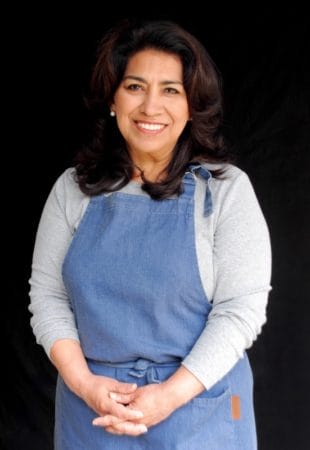 You mention in the book’s introduction that one of the reasons you started the blog was because you felt like the Mexican cooking blogs that were out there weren’t representing Mexican food for what it was. What did you feel was missing?
You mention in the book’s introduction that one of the reasons you started the blog was because you felt like the Mexican cooking blogs that were out there weren’t representing Mexican food for what it was. What did you feel was missing?
There weren’t many at that time, but the few I saw were written by people that maybe have some Mexican background in the family but had never lived in Mexico. Which is a different experience. I came to the States to live for the first time when I was 31. Then I moved back to Mexico and only came back here to live for good when I was 43. So I am a middle-aged Mexican woman who has lived most of her life in Mexico. And then I come here and see that some people who have never lived in Mexico are writing about Mexico food. To me, it didn’t represent what we actually eat at home.
Not just that, my main reason was that I wanted to have all my recipes in one place for my son. At the beginning, I didn’t really think that other people would read it.
What was it like to make the jump from writing a very popular food blog to a cookbook? Were there any sort of changes you had to make or was it seamless?
It was a lot of work! We had to be even more detailed and specific – we used a number of recipes that are already on the blog, but I made them again to make sure things like the timing and the temperature were exact. I say “we” because my son helped me explain things in English. He always said, “Okay, tell me in Spanish, what do you actually want to say?” I would explain how I wanted people to do something in a certain way, and then he would say, “Oh, okay, so this is what you want to say.”
Although I should say that I always try to be very explicit with details on the blog, because I want people to be successful with a recipe. When they make one of my recipes at home, I want it to look almost exactly the same as the photo on my blog. I was a schoolteacher, that’s my background, and I want people to feel that they accomplished something. And it’s very important for me because as a teacher that’s the best reward – your children learn to read, you’re like, yes! They get excited about doing well but it’s a great reward for us teachers to see that you were able to transmit something and somebody has a new skill.
That’s one of the things that I wrote in the introduction: If one of these recipes becomes a favorite or one that you keep making again and again in your life, that’s it for me, that’s a reward for me. I’m feeling happy because now it’s a part of your family, your memories and your traditions.
As someone who has a lot of experience on online cooking forums and sharing recipes that way, how do you think the Internet has shaped the way that people engage with and share recipes? Do you think that it’s changed what people expect from recipes or from the people developing them?
Something that used to be so far away or very remote, like learning to cook from someone in Greece or in Italy, is now possible. Now people are teaching cooking classes in France to 10-year-olds here in the US – I have a friend who said, my son learned how to do this French dessert. We paid $30 to someone in France, and she taught him via Zoom how to do it.
So what used to be impossible is now a reality. But the other thing is that we have become more demanding as users, in that we expect things to be quick – nowadays, everything is fast. People don’t want recipes that are complicated, that take 45 minutes. No, they want easy, fast, quick, five ingredients. But I also recognize that’s how it is now in the world.
The Internet has certainly increased communication between the people who are sharing their recipes and the people who are using them.
I will always read all the comments and try to find out how I can help. People know that about me – I always tell them, I’m available, send me a message on Instagram because I always have my phone. Like right now, several people are cooking the three kings’ bread, and I wrote at the end of the recipe that this is a complicated process and takes time, but to message me if you need any help. I’ve spent the past two days helping a girl in Scotland and someone from the Netherlands who are both making the recipe. I know they spent all that money to buy all those eggs and flour and everything, and I wanted them to be able to make it. Especially because most of the people I hear from are Mexicans living outside the country, and they miss home. So I wanted them to be able to make the bread and for a moment feel that they are back home.
It’s a very powerful feeling to recreate something that makes you feel like you’re back home.
There was a comment on Amazon that somebody wrote that said my entire childhood is in this book. And some people say, this just makes me remember when I was a little kid and I was in my grandma’s kitchen. And that’s what I wanted, I wanted people to have the recipes we’ve eaten all of our lives. It’s so funny, one lady said, “I bought 14 books. I gave them to everybody in my family because I want them to have the same recipes that we cook everyday.”
The new generations have to work hard, both men and women. It’s not the old days when grandma was in the house, or mom was staying home and she would cook nice meals. So I wanted people to have that within reach in a book. And if they ever feel homesick, they can cook something, maybe as simple as noodle soup, to feel closer to home.
It sounds like your aim was to recreate the home kitchen. How did you decide which recipes to include in the book? Since there’s such a wide range of cuisines in Mexico, was geographic diversity an important factor for you?
It was not an easy choice because there are many classics that aren’t in the book, like chilaquiles. We wanted to add the most popular recipes from the website, but we also wanted to have others that aren’t on the blog but that people will remember from their childhood. Some of the recipes maybe don’t sound too Mexican, like chicken salad, which is kind of like a Russian salad. But we love this salad and eat it at big events, like children’s parties, bridal showers, that type of thing. We’re hoping that everybody will find something that they can relate to.
Is there anything that I missed or that you think our readers would find interesting?
Just to know that if they buy the book or visit the website and have any questions while cooking, they should message me – I always answer.
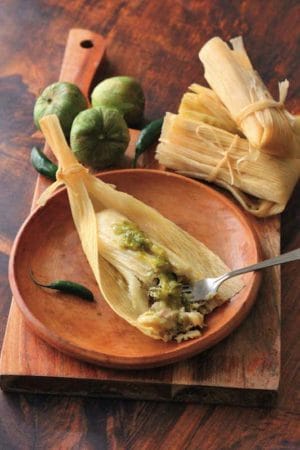 Recipe: Tamales de Pollo en Salsa Verde (Chicken in Green Salsa Tamales) from The Mexican Home Kitchen
Recipe: Tamales de Pollo en Salsa Verde (Chicken in Green Salsa Tamales) from The Mexican Home Kitchen
These tamales are among the most popular tamales in Mexico, particularly in the center of the country. They are also one of the most commonly known tamales in the United States. The word tamal comes from the Nahuatl word tamalli, meaning “wrapped.” Tamales are steamed in a leaf wrapper, usually a corn husk or a banana leaf, but other wrappers include avocado leaves, hoja santa, and other nontoxic leaves found in Mexico.
Prep time: 40 minutes
Cook time: 1 hour 40 minutes
Yield: 36 tamales
CHICKEN
1½ pounds (675 g) boneless, skinless chicken breasts
2 thick slices onion
2 cloves garlic
SALSA
1½ pounds (675 g) tomatillos, husks removed
6 serrano peppers or 4 jalapeño peppers
2 cloves garlic
Salt, to taste
DOUGH
36 medium corn husks, plus 10 more for lining the steaming pot
1¾ cups (360 g) lard
5 cups (615 g) masa harina for tamales
1 teaspoon baking powder
6 cups (1½ quarts/1.4 L) warm chicken broth, plus more if needed
Salt, to taste
1. To make the chicken: Place the chicken, onion, and garlic in a large stockpot. Cover the ingredients with water and cook over medium heat for 40 minutes, until the chicken is tender. Remove the chicken, let it cool, and then shred it with two forks.
2. While the chicken is cooking, make the salsa: Place the tomatillos, peppers, and garlic in a large pot with enough water to cover the ingredients. Cook, covered, over medium heat until they are cooked and tender, 15 to 18 minutes.
3. Transfer the tomatillos, peppers, and garlic to a blender, and blend until smooth. Season the sauce with the salt and mix with the shredded chicken. Set aside.
4. To make the dough: Place all the corn husks in a large bowl with warm water to soak for about 30 minutes; this will help make the husks soft and easily pliable when preparing the tamales. Remove the husks, drain any excess water, and set aside.
5. Place the lard in a large bowl and begin to beat it by hand or with a hand mixer until it acquires a lighter color and a slightly fluffy texture. Slowly incorporate the masa harina, baking powder, and warm broth. Continue mixing until all the ingredients are well incorporated, then season with the salt. If the dough looks too dry, add a little bit more broth to it, a couple tablespoons (30 ml) at a time.
6. To assemble the tamales, place a corn husk on your work surface with the wide end facing toward you. Place 2 to 3 tablespoons (15 to 30 g) of the dough in the center of the corn husk, closer to the bottom of the husk (the wide end). Using the back of a large spoon, evenly spread the dough toward the left, right, and bottom edges. The dough should reach all the way to the bottom edge (or just before it) but leave an inch (2.5 cm) of space on the left and right sides. Top the dough with 2 tablespoons (38 g) of the chicken filling. Fold the right and left sides of the corn husk in toward the center, overlapping each other and completely covering the dough and the filling. Next, fold the narrow end of the husk up toward the center. Repeat this process for the remaining 35 husks, dough, and filling. I usually line up the formed tamales on a tray as I make them.
7. To steam the tamales, place a steamer rack inside a large stockpot. Add enough warm water so that it almost reaches the steamer rack, then line the rack with a layer of corn husks. Place the tamales in the pot in an upright position, with the open ends facing up. Cover them with a generous layer of husks, then cover the pot. Steam the tamales for about 1 hour over medium heat. During the steaming, check the pot to see if it has enough water (be careful when removing the lid), adding more if needed (see Notas). To check if the tamales are ready, remove one from the pot, wait 5 minutes, then open it. If the husk separates easily from the dough when you open it, that means that the tamal is ready. If the dough sticks to the husk, place it back in the pot and cook for 15 more minutes.
8. Serve the tamales while still hot; just let them rest for 5 minutes first so the dough can firm up.
NOTAS
– Instead of the lard, you can use shortening or even vegetable oil.
– To beat the dough, I usually use a hand mixer, but I use a stand mixer when making a large batch of dough.
– When assembling tamales, cooks do not actually measure out the specific amounts of dough and filling that are added to every husk. Instead, they spoon on the amounts that they deem appropriate, while trying to stay within a consistent range. The amounts used can depend on how much area the corn husk has (they may vary in size), as well as how large the cook wants the tamales to be.
– You can tie the tamales with a strip of corn husk. It is not necessary, but it does help to keep them intact during the cooking process (this is especially true when making larger tamales). Some people use the strip as an indicator when making different types of tamales, only tying one type so that it’s easy to tell which is which without having to open them.
– If you need to add more water to the pot when steaming the tamales, make sure to pour it as close to the wall of the pot as possible, avoiding the tamales. If water gets into the tamales, they will lose their flavor and the dough will be soggy.
– One trick Mexican cooks use is to place a coin at the bottom of the pot underneath the steaming rack. If the water evaporates, the coin will start rattling, letting you know that you need to add more water to the pot.
– Tamales can be frozen in plastic bags for up to 4 months. You can reheat frozen tamales in the microwave for 2 minutes per tamal if they are frozen and 1 minute if they are thawed, re-steam thawed tamales for 15 minutes, or place thawed tamales, with the corn husks still on, in a skillet over medium-high heat for 10 minutes. The corn husks will start roasting, which will add an extra smoky flavor to the tamales. Turn them 2 or 3 times until warm.
Published on January 12, 2021







































